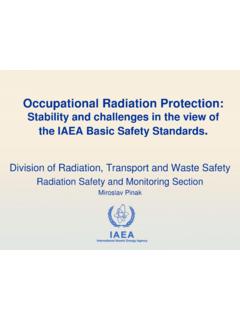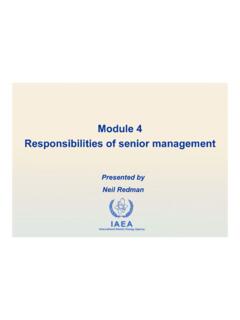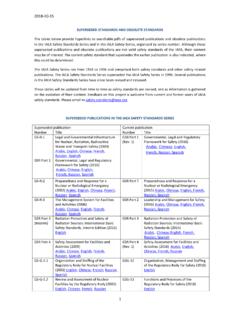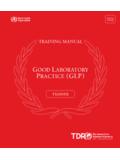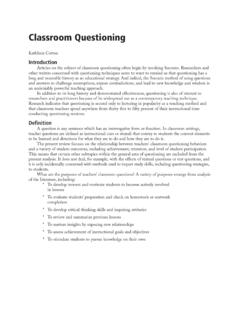Transcription of Training in Emergency Preparedness and Response
1 Society and the Environment Working to Protect People, Training in Emergency Preparedness and Response Nuclear Safety and Security Programme Nuclear Safety and Security Programme Training in Emergency Preparedness and Response The Incident and Emergency Centre (IEC) offers a wide range of Training courses and workshops to address the needs of Member States in the development, maintenance and testing of their Emergency Preparedness and Response (EPR) arrangements for nuclear and radiological incidents and emergencies. The IAEA Training programme in EPR aims to transfer knowledge and practical know-how and to create a sustainable learning and development framework in participating Member States. The Training programme targets a broad range of professionals and practitioners in the area of nuclear and radiological EPR, including: Decision makers Emergency planners Emergency Response coordinators Staff of regulatory bodies Radiation protection officers Radiological assessors Medical personnel First responders Training officers Public information officers QUICK GUIDE.
2 Actions to Protect the Public in an Emergency due to Severe Conditions at a Light Water Reactor Communication with the Public in a Nuclear or Radiological Emergency Cytogenetic Dosimetry: Applications in a Nuclear or Radiological Emergency Developing a National Capability for Response to a Nuclear or Radiological Emergency Dosimetry Basis for Protecting the Public in a Nuclear or Radiological Emergency Emergency Preparedness and Response for States Embarking on a Nuclear Power Programme First Response to a Radiological Emergency Medical Response to a Nuclear or Radiological Emergency Monitoring during a Nuclear or Radiological Emergency Notification, Reporting and Requesting Assistance in a Nuclear or Radiological Emergency On-site Procedures to Support Off-site Decision Making for an Emergency at a Nuclear Power Plant Optimization of Emergency Preparedness and Response Preparation, Conduct and Evaluation of Exercises to Test Preparedness for a Nuclear or Radiological Emergency Preparedness and Response for an Emergency at a Research Reactor Radiological Assessment in Response to a Radiological Emergency Nuclear Safety and Security Programme E DU CATIO N AND Training .
3 Training in Actions to Protect the Public in an Emergency due to Severe Conditions at a Light Water Reactor URL: Objective of the Training course duties safely, and that Response organizations identify the knowledge, skills and abilities necessary to be This Training course provides participants with an able to perform the Emergency Response functions. A. understanding of the actions necessary to protect the further requirement of IAEA publication GS-R-2 is that public in the event of an Emergency involving actual or these persons make arrangements for the selection of projected severe fuel damage in a light water reactor personnel and Training to ensure that the personnel (LWR) or spent fuel pool. It provides and explains selected have the requisite knowledge, skills, abilities, the basis and the criteria for decisions regarding equipment, procedures and other arrangements to public protective actions during an Emergency . perform their assigned Response function. This Training is based on the IAEA publication Actions to Protect the Public in an Emergency due to Severe Conditions at a Light Water Reactor (EPR-NPP PUBLIC PROTECTIVE ACTIONS 2013).
4 Participants will be trained on: making decisions to protect the public based on nuclear power plant conditions; making decisions to protect the public based on environmental measurements made after a release of radioactive material; and putting the radiological health hazard in perspective for the public and answering key questions, such as "Am I. safe?" and "What do I need to do to protect myself and family?". Based on the IAEA safety standards The Training programme on Preparedness and Response for nuclear and radiological emergencies follows IAEA Safety Standards Series No. GS- R- 2, Preparedness and Response for a Nuclear or Radiological Emergency (2002), which includes the following requirements: that all persons associated with performing functions in a radiation Emergency have to be suitably trained and qualified so that they understand their responsibilities and perform their E DU CAT I O N A ND T R A I N I N G. Target Audience Operating Law Health Regulators Vendors Educators Governments TSOs Nuclear Installation Safety Organizations Enforcement Sector Standardized Training courses in Target audience support of national and regional Training Participants are decision makers and their support staff, Emergency planners at facility and The IAEA Training programme on Emergency local levels, Emergency Response coordinators Preparedness and Response develops and and Emergency managers.
5 Makes available standardized courses, including lecture materials, tools and other resources to Target Member States support national and regional capacity building. Radiation Protection All Member States The concept of self-sustained education and Training in Member States Duration Training in Preparedness and Response for 5 days nuclear and radiological emergencies is pre- dicated on the concept of self-sustained education and Training in Member States. Competence is Languages acquired, developed and maintained through an Waste Management Only available in English established programme of Training . Transport Safety Emergency Preparedness and Response Nuclear Security For further Information: Related Technical Areas Contact: See: Write to: Incident and Emergency Centre Department of Nuclear Safety and Security International Atomic Energy Agency Vienna International Centre, PO Box 100. 1400 Vienna, Austria 13-26551. EDUCATION AND Training . Nuclear Safety and Security Programme E DU CATIO N AND Training .
6 Training in Communication with the Public in a Nuclear or Radiological Emergency URL: Objective of the Training course GS-R-2 is that these persons make arrangements for the selection of personnel and Training to ensure that This Training course provides practical Training to the personnel selected have the requisite knowledge, those responsible for communicating with the public skills, abilities, equipment, procedures and other and the media, and for coordinating with all sources arrangements to perform their assigned Response of official information, in a nuclear or radiological function. Emergency . This Training course presents the many goals in strengthening the efficiency of public communications in Preparedness and Response to a nuclear or radiological Emergency , which include supporting the implementation of public protective actions, mitigating the consequences of fear, and gaining and maintaining public trust. This Training is based on the IAEA publication Communication with the Public in a Nuclear or Radiological Emergency (EPR-Public Communications, 2012).
7 Based on the IAEA safety standards The Training programme on Preparedness and Response for nuclear and radiological emergencies follows IAEA Safety Standards Series No. GS-R- 2, Preparedness and Response for a Nuclear or Radiological Emergency (2002), including the following requirements: that all persons associated with performing functions in a radiation Emergency have to be suitably trained and qualified so that they understand their responsibilities and perform their duties safely, and that Response organizations identify the knowledge, skills and abilities necessary to be able to perform the Emergency Response functions. A further requirement of IAEA publication E DU CAT I O N A ND T R A I N I N G. Target Audience Operating Law Health Regulators Vendors Educators Governments TSOs Nuclear Installation Safety Organizations Enforcement Sector Standardized Training courses in support of national and regional Training The IAEA Training programme on Emergency Preparedness and Response develops and makes available standardized courses, including lecture materials, tools and other resources, to support national and regional capacity building.
8 Radiation Protection The concept of self-sustained education and Training in Member States Training in Preparedness and Response for nuclear and radiological emergencies is pre- dicated on the concept of self-sustained education and Training in Member States. Competence is Waste Management acquired, developed and maintained through an established programme of Training . Target audience Participants are public information officers at facility, local and national levels, Emergency managers and Emergency coordinators. Transport Safety Target Member States All Member States Duration 5 days Emergency Preparedness Languages and Response Available in English, French and Spanish Nuclear Security For further Information: Contact: Related Technical Areas muncation- Write to: Incident and Emergency Centre Department of Nuclear Safety and Security International Atomic Energy Agency Vienna International Centre, PO Box 100. 1400 Vienna, Austria 13-26481. EDUCATION AND Training . Nuclear Safety and Security Programme E DU CATIO N AND Training .
9 Training in Cytogenetic Dosimetry: Applications in a Nuclear or Radiological Emergency URL: Objective of the Training course This Training course provides participants with know- ledge on how to select and implement, in a standard- ized manner, the appropriate cytogenetic technique to ensure comparable dose assessment following acci- dental exposure to ionizing radiation. It is based on the IAEA publication Cytogenetic Dosimetry: App- lications in Preparedness for and Response to Rad- iation Emergencies (EPR- BIODOSIMETRY 2011). Based on the IAEA Safety Standards The Training programme on Preparedness and re- sponse for nuclear and radiological emergencies follows IAEA Safety Standards Series No. GS-R-2, Preparedness and Response for a Nuclear or Radio- logical Emergency (2002), which includes the follow- ing requirements: that all persons associated with performing functions in a radiation Emergency have to be suitably trained and qualified so that they under- stand their responsibilities and perform their duties safely, and that Response organizations identify the knowledge, skills and abilities necessary to be able to perform the Emergency Response functions.
10 A fur- ther requirement of IAEA publication GS-R-2 is that these persons make arrangements for the selection of personnel and Training to ensure that the personnel selected have the requisite knowledge, skills, abilities, equipment, procedures and other arrangements to perform their assigned Response function. E DU CAT I O N A ND T R A I N I N G. Target Audience Operating Law Health Regulators Vendors Educators Governments TSOs Nuclear Installation Safety Organizations Enforcement Sector Standardized Training courses in Target audience support of national and regional Training Participants are biologists, medical technolo- gists, and laboratory staff performing biological The IAEA Training programme on Emergency dosimetry and relevant medical specialists (phy- Preparedness and Response develops and makes sicians, radiopathologists and haematologists). available standardized courses, including lecture materials, tools and other resources to support Target Member States national and regional capacity building.


